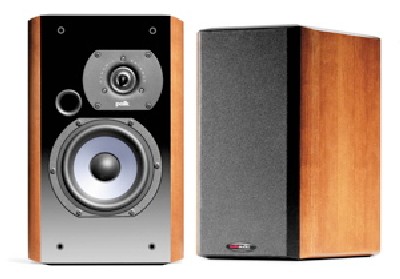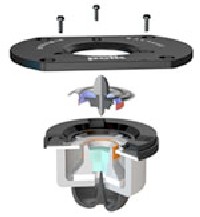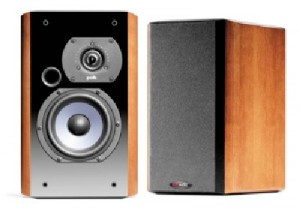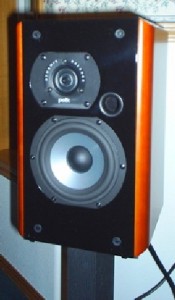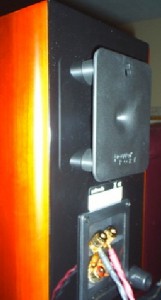Twenty-six years ago I walked into Profound Sound in Lakewood, Colorado. I was fixated on buying a certain speaker, as I had been reading/drooling about it for months, sadly, for the wrong reason. For you see, my grandfather had built me a solid oak stereo stand, and having my mother’s taste for visual appeal I wanted speakers to match. Upon announcing what I was looking for, the salesman, Foote (a legend in Denver-Boulder audio sales), quickly ushered me to the speakers of my choice. He played a few selections for me and I quickly agreed these were the speakers I wanted. As Foote went to the back to grab the boxes, another salesman switched over to a different set of speakers. Suddenly, I heard some of the sweetest sound I had ever encountered. I pivoted back around and was greeted by rather ugly burgundy vinyl rectangles. But the sound, oh that sound. I was enamored to say the least. Upon Foote’s return I asked about the speakers that were playing, he excitedly replied that they were the Polk Audio 10’s and they sold for $600. Unfortunately, $175 more than I had to spend. Focusing back on the beautiful oak veneer, I shook off my buyer’s remorse and went home with what I came into purchase.
Specifications:
Driver Complement
- Mid/Woofer 1 – 5-1/4″ Diameter (13.34cm) Tweeter 1 – 1″ Diameter (2.54cm) Ring Radiator Overall Frequency Response 45Hz – 27kHz Lower -3dB Limit 53Hz
- Upper -3dB Limit 26kHz Nominal Impedance 4 ohms Recommended Amplifier Power 20 -150 w/ channel
- Efficiency 88 dB
- Crossover 2.4kHz; HPF 18dB/oct, LPF 12dB/oct.
- Inputs Dual 5-way binding posts for bi-amp/bi-wire
- Dimensions 13-5/8″ H x 8-5/8″ W x 10-1/4″ D
- Mounting Options Bookshelf, stand, on-wall with built-in keyhole slot
- Enclosure Type Vented via rear-mounted Power Port and a single front mounted ARC port
- Product Weight 21.00 lbs. (9.53kgs) each
- Side panel finishes: medium cherry or ebony
- Price $919 retail
Over the next two years I couldn’t get the sound of the Polk 10’s out of my mind. One Christmas vacation afternoon I decided to drive up to Boulder to check out a used stereo shop, Recycled Audio. To my surprise, Foote was there and remembered me. After a couple of minutes of bantering, I went browsing, and there on the bottom shelf was a pair of 10’s. After listening Foote and I agreed on a trade-in price for my original speakers and I became the proud owner of the Monitor 10’s. Quickly, I got a hold of some flexible oak veneer and covered the vinyl with real wood and stained it to match my cabinet, and so began my appreciation of Polk products.
Fast-forward to November 2005, I was in a Fry’s store and the Polk banner caught my eye. I went back to the sound rooms to look over the offerings. Not only did they have the RTi line in the gorgeous medium-dark cherry veneer, but to my surprise the LSi series as well. Since all the sales reps were busy I quickly figured out for myself the control panel and began listening to the various speakers. In comparing the RTi’s to the LSi’s it was apparent that the LSi’s were designed for better equipment than what Fry’s had on hand to drive them. I filed the information away and went about my shopping quest that day.
Polk Audio LSi7 review
In June, I made contact with Paul DiComo, marketing manager of Polk Audio. Since A$$A had published a reprint of a Polk Forum review of the LSi9’s I decided to ask for the LSi7’s, since I have been focusing on the monitor offerings to the market. After a few months while Paul took some time to enjoy a vacation, followed by the sale of Polk Audio, the LSi7’s arrived. To my pleasant surprise, a deeper, more reddish classic cherry stain had replaced the lighter cherry stain side panels. The look is more elegant and blends better with the pianoblack top and bottom.
LSi7 Design
The LSi7’s qualify for the monitor category instead of the mini, but just barely, in my opinion. The attached one-inch thick cherry veneer side panels actually make the cabinets look shorter than they actually are at 13 inches tall. Upon removing the grill the eyes are immediately drawn to the Ring-Radiator tweeter. This missile cone design can be seen in some very high-end speakers. It is also a sign that the crossover network must be top notch as some in the industry have pointed out that this tweeter design needs to be kept under control. Since the speakers are pair matched, the tweeter is offset to the outside edge.
The 5-1/4’s driver uses an aerated cone that is constructed to present a low distortion and wide frequency response output. Framing the cone is an aluminum basket that Polk claims virtually eliminates ringing and flexing. Polk has long offered smaller main drivers, from the 6-1/2 inch polymer coated models of the original Monitor and SDA series. This hallmark has allowed Polk speakers to always image and handle transients without problem. A front port, located just inside the lower half of the tweeter finishes the front panel.
On the backside the top half is taken up by Polk Audio’s semi-famous PowerPort. This cone attached to a flange design, minimizes the dreaded “chuffing” that can occur as air pushes its way out of the port. A secondary benefit is that the PowerPort allows the speaker to be hung on the wall thru a keyhole etched in the flange. A pair of rubber feet comes attached on the bottom corners in order to allow for a perfectly hung balanced placement. Two sets of gold plated binding posts allow for bi-amping/wiring. Those of you using banana plugs be warned, you cannot plug the cables in thru the top of the binding post. Paul DiComo Comments: “You can remove the plastic inserts by unscrewing the binding post nut all the way off and prying out the inserts. They are there to satisfy European safety regulations that are not relevant in the USA.”
The speakers were placed in a closet hooked up to a Sony receiver where they spent the next week playing 24/7 at a mid-volume. (I should mention that Paul had the speakers in his office playing before they were shipped to me) Paul wrote in a white paper on the LSi’s that he believed they sounded better with solid state equipment. I would be remiss if I didn’t mention that the LSi owners in the Polk forum are united in agreement that the entire line craves power. In a thread I posted in the forum asking for the wpc of owners, the average was 300+ per channel with a high of 600 watts. However, it should be noted that quality power is far more important than the quantity of power.
Of course, I had to test solid state preferred theory by hooking up my newly acquired Onix SP3 integrated tube amp. I turned on the SP3 and went off and did some honey-do’s while the tubes warmed. A little over an hour later, I came back to listen. The results, the mids and highs were clear and airy. However, the bass was too light, more puffy than solid. That surprised me, but I chalked it up to the LSi’s as being solid-state power hogs. Sometime later I found out the truth, the SP3 was plugged into the outlet of a wired wall switch. Inadvertently, my wife had flipped the switch to the off position, only to flip it back up just before I came back into the living room.
The next integrated amplifier I tried was a just arrived Music Hall A25.2 integrated solid state at 100 wpc @ 4 ohms. There was a definite improvement in the bass output but they depth I was hoping to hear wasn’t quite evident. Although the amp had been previously opened I cannot attest to it’s run-in time. Once again the mids and highs were spacious and smooth, though not as warm as the tubebased SP3. But, in fairness to the LSi7’s I continued moving up the amplifier power ladder.
Next, I grabbed my Adcom GFA-535 amplifier and matching GTP-450 preamp/tuner. Based on other Adcom amps its 4 ohm rating should be approximately 100 wpc, but is well known to easily exceed its ratings. Now, I began to hear the resonance. A couple of days later I grabbed my most powerful amp, the Harman Kardon PM665XVi. At 150 watts a side into 4 ohms I heard the same depth and a bit more beyond the Adcom in certain tracks. The balance of my several critical listening sessions were accomplished using one amplifier or the other.
Just before going to print I found out about the SP3 amp debacle, I hooked the amp back up to the speakers, let it warm for a good ninety minutes. Lo, and behold, the bass was present and tight. The sonics were crystal clear. With the lights off I lost sense of where the speakers were. LSi7’s had transported me to the recording studio.
Listening LSi7
My first session with the h/k, Polk pairing was casual as my wife and I relaxed on the couch listening to James Taylor’s Greatest Hits. I was struck quite quickly at how well the LSi7’s presented the troubadour’s voice. Most speakers have a tendency to add a hint of nasalness. Not the LSi7’s, instead, I heard the depth and richness that the finest of speakers brings forth. I believe part of this is due to the stunning capability of the Ring Radiator tweeter. It just refuses to add unwanted frequencies to the music.
After my wife scurried off to bed, I put in my current favorite JT cd, Hourglass; sat in my preferred listening position with the lights off and allowed the speakers to create a soundstage. True to their mini-monitor nature, the LSi7’s love acoustic music and singersongwriters. Taylor’s vocals, always clear, are especially crisp on this cd. From the nifty diddy,Line ‘Em All Up, to intoxicating ballad Gaia. This track has become a personal favorite during critical listening sessions, with its subtly sweet soprano sax solo by Branford Marsalis, to the rumbling instrumental thunderclap. The LSi7’s gracefully allowed each moment it’s own space.
Over the next several sessions a couple of observations became absolutes, the LSi7’s are a critical listeners delight, so many subtle details that are lost on lesser speakers, become splashes of sonic color on the Polk’s. The result at the end of every album I put on was a feeling of satisfaction.
One excellent example of image placement is the drumming of Russ Kunkel in Dan Fogelberg’s Higher Ground. Never have I heard the initial roll coming from a spot so far to the outside of the left speaker. From that starting point it glided across the soundstage to a point equally to the far end right speaker. The movement is only half of what makes it so pleasurable; it’s that each individual note remains clear, not muffled. The LSi7’s performed that exercise deftly. Another audio detail that I appreciated in the LSi7’s, is its skill in reproducing picking of string notes by electric guitars. Most tweeters fall short on effort, presenting fuzzy remnants, which ends up clashing with work of the driver.
One of the most distinguished voices in music belongs to the Dixie Chicks Natalie Maines. The very slight twang is offset by an edginess that is matched only by her strong opinions. In Wide Open Spaces this combination stands out on the LSi7’s. Other speakers I have auditioned have produced the clarity, but not the resonance of her vocals to the extent of the Polk’s.
I suspected that classical recordings by large orchestras would disappoint as most mini-monitors struggle to duplicate the immensity of sound. Instead I was pleasantly surprised, even with the lack of bass below 50hz how well the LSi7’s handled the complex passages of Beethoven’s Ninth Symphony. The layering of each orchestral section is easily distinguishable even during the most energetic of movements.
All speakers have their faults or weaknesses, and the LSi7’s are no exception. The binding posts with their lack of banana plug-in disappointed me. It would have been nice for Polk to mention the removal capability of the tabs. Sonically, hard rock and hip-hop, requiring thundering bass and mushy convolution of notes leave these speakers dull and limited. If these were living, breathing entities, I say they were bored. In reality, they weren’t designed for the loud pounding of a head bangers ball. Rather, they feast intimate times where actual listening takes place.
Comparisons
I spent many hours one day connecting wires back and forth between the LSi7’s and my reference pair, the Totem Acoustic MITES. The MITES are a true mini-monitor, therefore, sound comparison is a bit tilted toward the LSi7’s, but they also are almost $300 more expensive. Immediately, I picked up on the high frequency difference. The MITES are a bright speaker, not harsh but truly bright. When played thru my Onix SP3 Tube amplifier the MITES highs are calmer, for lack of a better word. The LSi7’s are softer in the upper frequencies due to the effort of the Ring Radiator tweeter. The Polk’s mids play about a third of an octave lower, giving the LSi7’s a sense of size and presence that the MITES lack. The overall sound difference was far greater with solid state gear than with the tube Onix SP3 powering both brands.
Conclusions about Polk Audio LSi7
It’s always a positive sign when an audio manufacturer decides to create a higher line of equipment. In the case of Polk Audio, this came at a time when many in the audio community were pounding on Polk for signing on with the “big box’ stores. The LSi line became their biggest reach since the development of the SDA series in the mid-1980’s. From the overall positive reviews of the audio press community, a successful one at that. I know that I enjoyed every minute of my listening time with the LSi7’s, and will truly miss them when it’s time to send them back to Baltimore.
In the LSi7, Polk has created a speaker capable of standing with the elite thousand dollar audio monitors. In this ever-increasing field that is quite an accomplishment. With its usage of the Ring-Radiator Tweeter and a Mylar bypass capacitor in the crossover, the attributes of this tweeter comes shining thru in spades. The midrange and upper bass exude a naturalness and depth reserved for the upper crust of audio names. Just keep in mind that component matching is critical; as the LSi7’s crave power and anything less than 100 solid state wpc into 4 ohms will leave you wanting. I can only imagine how well these would sound hooked up to a Krell 400i, or something similar.
Associated Equipment:
- Adcom GFA535, GTP450
- Harman Kardon PM665Vxi , Onix SP3
- Onix CD5
- Totem MITES
- Apple iPod 60 gig (AIFF only), Zebra Cables
- Celestion Si stands.
from affordableaudio, By Mark Marcantonio
